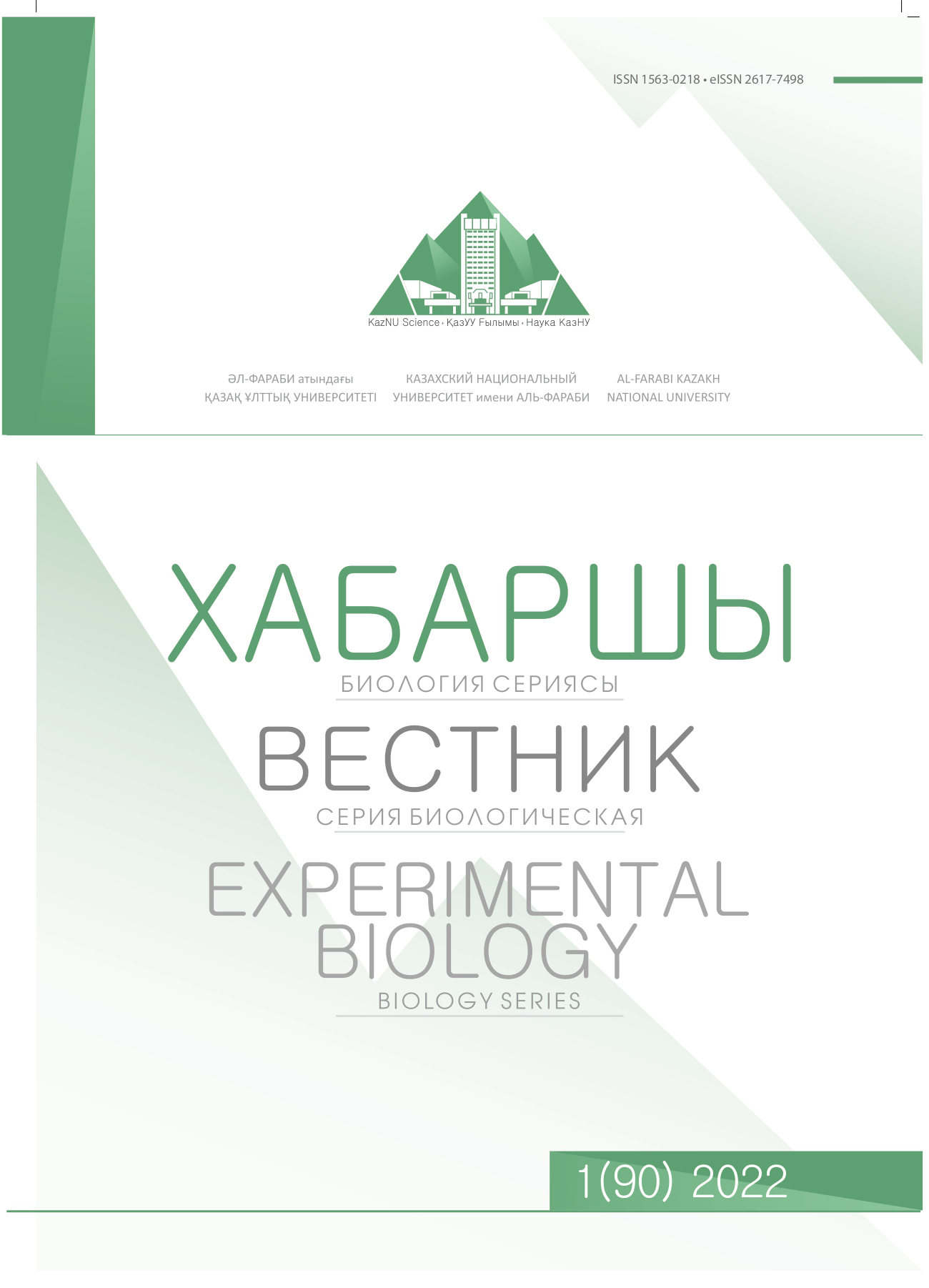PROSPECTS AND POSSIBILITIES FOR PROCESSING ENDOCRINE-ENZYMED AND SPECIAL RAW MATERIALS
DOI:
https://doi.org/10.26577/eb.2022.v90.i1.14Abstract
The article talks about a large number of unused resources in the field of medicine, where endocrine- enzyme and special raw materials of farm animals can be used for medicinal purposes, an analysis of technologies for processing bile of cattle is carried out. The fact that the bile of wild animals contains a wide range of biologically active substances has been known since ancient times.
The development of pharmacology makes it possible to fully reveal all the beneficial properties of endocrine-enzyme and special raw materials for the development of various therapeutic drugs.
The demand for cattle on the world market is very high. Therefore, one of the effective directions is the collection and processing of endocrine-enzyme and special raw materials for the production of medical and veterinary drugs. Currently, endocrine-enzyme and special raw materials are not processed in Kazakhstan. Therefore, this article discusses the main directions in the field of bile processing and processing of meat obtained during slaughter of cattle, ways to develop technologies for long-term preservation of product quality indicators that improve its quality. The most effective way of long-term storage is canning, i.e. the process of thickening. Depending on the age and sex of the animal, the bile can be thick or liquid. Therefore, the thickening process took place within 12-15 hours. Depending on this result, the optimal parameters of the thickening process were determined.
In the course of the study, the physical, chemical and biological composition, microbiological pa- rameters of bile were determined, and storage periods were established. The article presents the results of the study of bile.
References
Arlia-Ciommo A., Piano A., Svistkova V., Mohtashami S., Titorenko V.I. (2014) Mechanisms Underlying the Anti-Aging and Anti-Tumor Effects of Lithocholic Bile Acid. Int. J. Mol. Sci, vol. 15, pp. 16522-16543
Boyer J.L.(2013) Bile formation and secretion. Compr. Physiol, vol.3, pp. 1035–1078.
Dodds W.J., Groh W.J., Darweesh R.M., LawsonL., Kishk S.M., Kern M.K.(1985) Sonographic measurement of gallbladder volume. AJR Am. J.Roentgenol, vol. 145, pp. 1009-1011.
Eggert T., Bakonyi D., Hummel W.(2014) Enzymatic routes for the synthesis of ursodeoxycholic acid. J. Biotechnol, vol.191, pp. 11-21.
Everson G.T., Braverman D.Z., Johnson M.L., Kern F.Jr.(1980) A critical evaluation of real-time ultrasonography for the study of gallbladder volume and contraction. Gastroenterology, vol.79, pp. 40-46.
Gill P.T., Dillon E., Leahy A.L., Reeder A., Peel A.L.(1985) Ultrasonography, HIDA scintigraphy or both in the diagnosis of acute cholecystitis? Br. J.Surg, vol.72, pp. 267-268.
Gubitosi M., Trillo J.V., Vargas A.A., Pavel N.V., Gazzoli D., Sennato S., Jover A., Meijide F., Galantini L. (2014) Characterization of Carbon Nanotube Dispersions in Solutions of Bile Salts and Derivatives Containing Aromatic Substituents. J. Phys. Chem. B., vol. 118, pp. 1012-1021.
Hofmann A.F., Hagey L.R. (2014) Key discoveries in bile acid chemistry and biology and their clinical applications. J. Lipid Res, vol. 55, pp. 1553-1595.
Kong W., Wang J., Xing X., Xiao X., Zhao Y., Zang Q., Zhang P., Jin C., Li Z., Liu W.(2011) Antifungal evaluation of cholic acid and its derivatives on Candida albicans by microcalorimetry and chemometrics. Anal. Chim. Acta, vol. 689, pp. 250-256.
Lin, Kohli R.(2018) Bile acid metabolism and signaling: potential therapeutic target for nonalcoholic fatty liver disease, Clin. Transl. Gastroenterol, vol.9, pp. 164, https://doi.org/10.1038/s41424-018-0034-3.
Pat. WO 2011/075701 A2. Methods for the purification of deoxycholic acid. Moriarty R.M., Prasad A.R., Reid J.G., Swaringen Jr. R.A., KYTHERA BIOPHARMACEUTICALS, INC. – 23.06.2011.
Qiao Y., Lin Y., Zhang S., Huang J.(2011) Lanthanide-Containing Photoluminescent Materials. From Hybrid Hydrogel to Inorganic Nanotubes. Chem. – Eur. J., vol. 17, pp. 5180-5187.
Rodkiewicz C.M., Otto W.J., Scott G.W.(1979) Empirical relationships for the flow of bile. J.Biomech,vol.12, pp. 411-413.
Salvador J.A.R., Carvalho J.F.S., Neves M.A.C., Silvestre S.M., Leitão A.J., Silva M.C., Sá e Melo M.L.(2013) Anticancer steroids: linking natural and semi-synthetic compounds. Nat. Prod. Rep, vol. 30, pp. 324-374.
Serfaty L., Poupon R. (2012) Therapeutic approaches for hepatobiliary disorders with ursodeoxycholic acid and bile-acid derivatives, Clin. Res. Hepatol. Gastroenterol, vol. 36, https://doi.org/10.1016/S2210-7401(12) 70014-1.
Sharma R., Long A., Gilmer J.F. (2011) Advances in Bile acid Medicinal Chemistry. Curr. Med. Chem, vol. 18, pp. 4029- 4052.
Blanchet M., Brunel J.M. Bile Acid Derivatives: From Old Molecules to a New Potent Therapeutic Use: An Overview // Curr. Med. Chem. – 2018. –Vol. 25(30). – P. 3613-3636.
Lısısyn A.B., Zaharov A.N., Neburchılova N.F., Volynskaja I.P., Petrunına I.V., Chernova A.S. (2015) Kompleksnoe i racional`noe ispol`zovanie pobochnogo syr`ja na predprijatijah mjasnoj otrasli. М.: ООО «Advansed Soljushnz», pp. 80.
Lisisyn A.B., Neburchilova N.F., Gorbunova N.A.(2015) Perspektivnye napravlenija povyshenija jeffektivnosti pererabotki pobochnogo syr`ja mjasnoj promyshlennosti . «Inovacii v intensifikacii proizvodstva i pererabotki sel`skohozjajstvennoj produkcii». Materialy Mezhdunarodnoj nauchno-prakticheskoj konferencii 17-18 ijunja 2015 g., Volgograd, pp. 209-212.
Lısısyn A.B., Neburchılova N.F., Petrunına I.V., Chernova A.S. (2015). Ispol`zovanie subproduktov v medicinskih celjah. Vse o mjase. vol. 2, pp. 6-9.
Lisicyn A.B., Neburchilova N.F., Volynskaja I.P.(2015) Istorija i perspektivy pererabotki jendokrinno-fermentnogo i special`nogo syr`ja. Mjasnaja industrija. vol. 3, pp. 25-27.
Lisicyn A.B., Neburchilova N.F., Volynskaja I.P. (2015) Istorija i perspektivy pererabotki jendokrinno-fermentnogo i special`nogo syr`ja. Mjasnaja industrija. vol.4, pp. 25-27.
Mashkovskij M.D.(1993). Lekarstvennye sredstva. М.: Medicina.no.1, pp. 604-605.
Tolysbaev B.S., Seısenbınova A.A.(2019) Qazaqstan respublıkasyndaǵy tamaq ónerkásibi kásiporyndarynyń ınovasıalyq damuy: problemalary men perspektıvalary. Ekonomıka: strategıa ı praktıka.vol. 1 (14), pp. 109-122.
Chomanov U.Ch., Kenenbaj G.S., Mambeshova A.T., Omirzhanova B.B. (2019) Issledovanie svojstva zhelchi iz zhelchnogo puzyrja. Nauka, proizvodstvo, biznes: mater.mezhdunar.nauchn.-konfer., 4-5 aprelja. Almaty, no. 4,pp.95-98.












